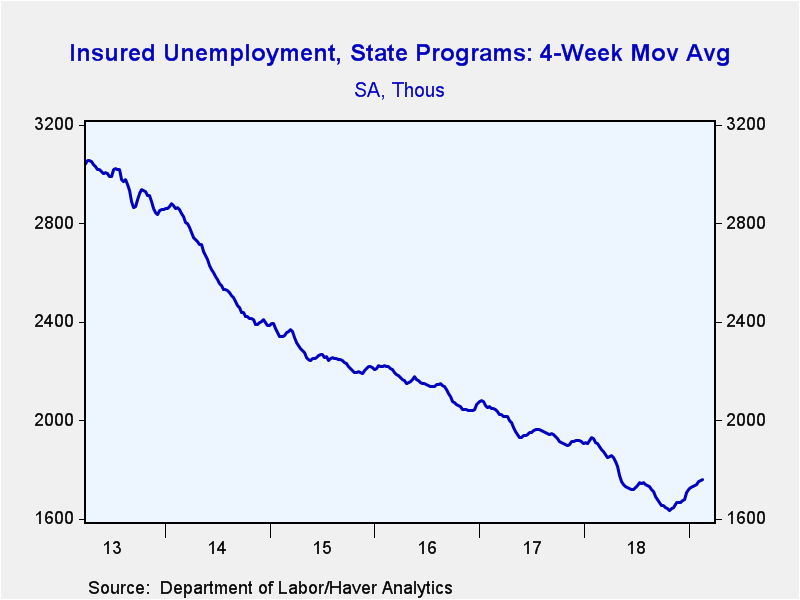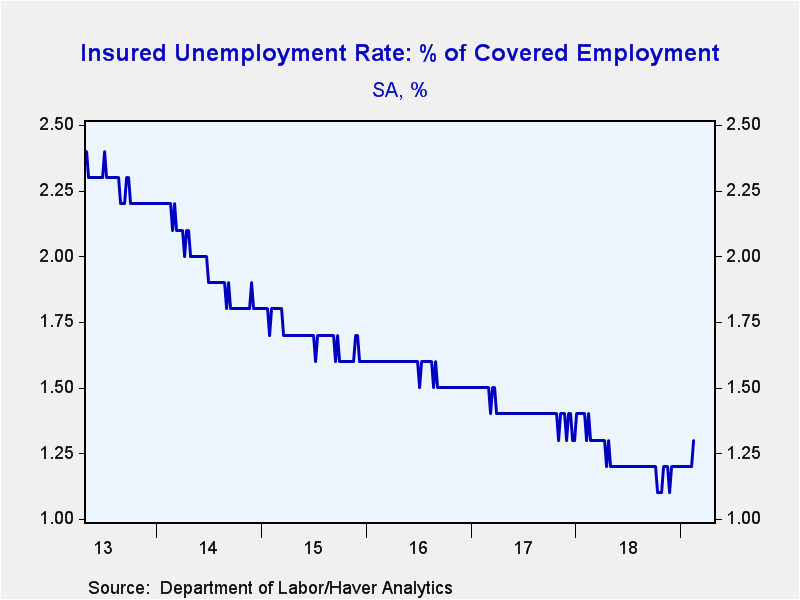 Global| Feb 28 2019
Global| Feb 28 2019U.S. Initial Claims for Unemployment Insurance Edge Higher; Continuing Claims Highest in 10 Months
Summary
Initial claims for unemployment insurance were 225,000 in the week ended February 23, up 8,000 from the previous week's 217,000; that figure was revised up by 1,000. The Action Economics Forecast Survey projected 221,000 claims this [...]
Initial claims for unemployment insurance were 225,000 in the week ended February 23, up 8,000 from the previous week's 217,000; that figure was revised up by 1,000. The Action Economics Forecast Survey projected 221,000 claims this week. Even with the latest weekly increase, the four-week moving average of initial claims fell back from the prior week's 13-month high of 236,000 to 229,000.
At the same time, continuing claims for unemployment insurance rose to 1.805 million in the February 16 week from 1.726 million the week before; that earlier figure was revised up by 1,000. The latest is the largest number of claimants in a single week since last April 14. The four-week moving average of continuing claims increased from 1.755 million in the February 9 week to 1.762 million; this is again the highest since last May 5.
With the larger number of continuing claims, the insured unemployment rate - that is, continuing claims as a percent of covered employment - rose to 1.3% in the February 16 week. This is still very, very low historically, but it does break a string of nine-and-a-half months at 1.2% or 1.1%, the latter being the record low in this 48-year span of data.
In their separate program, the number of federal government workers filing initial claims fell again in their latest reading, reaching 787 in the February 16 week, down from 919 the prior week. This sustains the more normal range for these claims that has re-emerged after the government shutdown had driven them markedly higher.
Insured unemployment rates in the state programs vary widely by state. These state data are not seasonally adjusted. During the week ending February 9, the lowest rates were in Florida (0.43%), North Carolina (0.50%), Georgia (0.62%), Tennessee (0.62%) and Virginia (0.64%). The highest rates were in Alaska (3.17%), New Jersey (2.73%), Montana (2.64%), Rhode Island (2.57%) and Connecticut (2.43%). Rates in other large-population states include California (2.12%), Texas (0.98%), New York (1.75%), Pennsylvania (2.35%) and Illinois (2.30%).
Data on weekly unemployment claims going back to 1967 are contained in Haver's WEEKLY database and are summarized monthly in USECON. Data for individual states are in REGIONW. The expectations figure is from the Action Economics Forecast Survey, carried in the AS1REPNA database.
| Unemployment Insurance (SA, 000s) | 02/23/19 | 02/16/19 | 02/09/19 | Y/Y % | 2018 | 2017 | 2016 |
|---|---|---|---|---|---|---|---|
| Initial Claims | 225 | 217 | 239 | 3.7 | 221 | 244 | 262 |
| Continuing Claims | -- | 1,805 | 1,726 | -6.1 | 1,766 | 1,967 | 2,135 |
| Insured Unemployment Rate (%) | -- | 1.3 | 1.2 |
1.3 |
1.2 | 1.4 | 1.6 |
Carol Stone, CBE
AuthorMore in Author Profile »Carol Stone, CBE came to Haver Analytics in 2003 following more than 35 years as a financial market economist at major Wall Street financial institutions, most especially Merrill Lynch and Nomura Securities. She has broad experience in analysis and forecasting of flow-of-funds accounts, the federal budget and Federal Reserve operations. At Nomura Securites, among other duties, she developed various indicator forecasting tools and edited a daily global publication produced in London and New York for readers in Tokyo. At Haver Analytics, Carol is a member of the Research Department, aiding database managers with research and documentation efforts, as well as posting commentary on select economic reports. In addition, she conducts Ways-of-the-World, a blog on economic issues for an Episcopal-Church-affiliated website, The Geranium Farm. During her career, Carol served as an officer of the Money Marketeers and the Downtown Economists Club. She has a PhD from NYU's Stern School of Business. She lives in Brooklyn, New York, and has a weekend home on Long Island.









